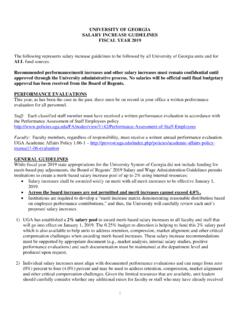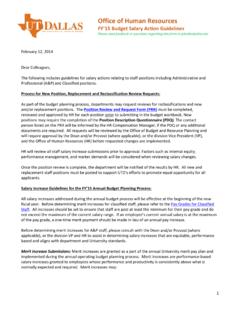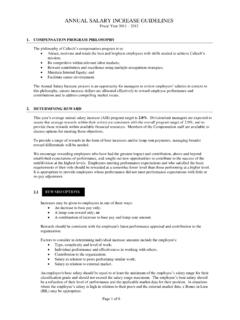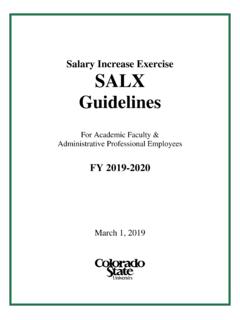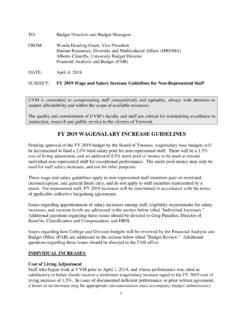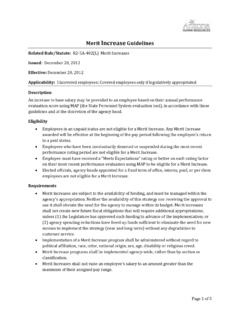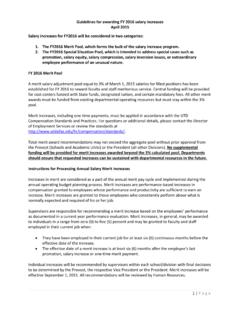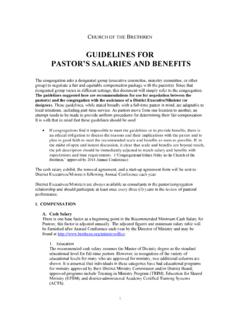Transcription of USC Wage and Salary Guidelines
1 USC wage and Salary Guidelines Revised June 2016 USC wage AND Salary Guidelines USC HUMAN RESOURCES Revised June 2016 2 Contents PREFACE 3 PRINCIPLES 3 MINIMUM PAY 3 ACCOUNTABILITY 3 PAY PRACTICES 3 PAY COMPARISONS 4 FUNDING 4 annual PAY INCREASES 4 PAY FOR TRANSFERS/REHIRES/RECLASSIFICATIONS/PROM OTIONS 5 FEDERAL AND STATE wage AND HOUR COMPLIANCES 5 MINIMUM wage 5 MINIMUM Salary 5 NEW FEDERAL EXEMPT MINIMUM Salary FOR FULL-TIME EMPLOYEES 6 OVERTIME PAYMENT 6 COMPENSATION INCREASES 6 ESTABLISHING WAGES/SALARIES 7 NEW HIRES 8 REHIRES 8 TRANSFERS 8 COMPETITIVE PROMOTIONS 8 DEMOTIONS 8 RECLASSIFICATIONS AND INTERNAL PROMOTIONS 9 FEDERAL AND STATE wage AND HOUR COMPLIANCES 9 DEPARTMENT 9 COMPENSATION OFFICE 9 OUT-OF-CYCLE (NON-FISCAL YEAR) COMPENSATION TRANSACTIONS 11 MARKET ADJUSTMENTS 11 APPROVAL REQUIREMENTS 11 PAY increase FUNDING 12 DISCRETIONARY BONUSES 12 OVERLOAD COMPENSATION 13 APPROVAL REQUIREMENTS 14 SPECIAL OVERLOAD PAYMENTS 14 REQUESTS FOR EIB COMPENSATION/ONE-TIME PAYMENTS 15 USC wage AND Salary Guidelines USC HUMAN RESOURCES Revised June 2016 3 Staff wage and Salary Guidelines Preface These procedures apply to staff employed by USC.
2 In the event of a discrepancy between these procedures and Guidelines and a collective bargaining agreement, the terms of the collective bargaining agreement will govern. Direct questions to the HR Service Center. Principles (back to Table of Contents) Principles Minimum Pay All departments must comply with federal, state and local wage and hour law including minimum wage and Salary rates, time and record keeping, overtime pay requirements and pay periods (see Staff wage and Hour Policies in the Employment and Workplace section of the USC Policy website). Accountability The authority, responsibility and accountability for staff compensation administration lies with managers, who are required to execute employment actions in accordance with the policies, practices and Guidelines established by the university and additional requirements that may be established by their schools and divisions.
3 Managers are required to consult with the person to whom they report on all employment decisions and transactions affecting the employees who report directly to them. This requirement for one level up review and support applies to issues including, but not limited to, all forms of compensation ( , Salary and wage rates, bonus compensation, overload compensation, allowances), perquisites, budget allocation, job postings, employment offers, terms and conditions of employment, hiring, promotions, reclassifications, demotions, reorganizations, and terminations. Pay Practices Managers are accountable for establishing and maintaining pay in accordance with these staff wage and Salary Guidelines and any additional requirements prescribed by the President, Provost and Senior Vice President for Academic Affairs, and Senior Vice President for Administration.
4 When determining wage or Salary rates, other compensation, perquisites or non-standard benefits, managers must consider factors such as marketplace comparisons, education and experience of the individual, fair and equitable distribution among employees in the same or similar position classifications, individual performance, and available funding. Schools and departments should initiate pay increases in Workday and approvals must be completed within Workday prior to any commitments being made to the employee. The university s compensation philosophy strives to target compensation at or between the 50th and 75th external market percentiles for well to extraordinarily qualified high performers who possess additional work experience, education, skills and knowledge beyond the minimum requirements of the position.
5 USC wage AND Salary Guidelines USC HUMAN RESOURCES Revised June 2016 4 Pay Comparisons The Compensation office is available to assist departments in reviewing compensation on a case-by-case basis. Compensation staff will provide Salary / wage averages by position, university-wide comparative data and/or external market data, if available, and/or make arrangements for custom surveys. Departments should use the recommended Guidelines from the Staff Compensation Benchmarking Report, distributed quarterly to HR Partners by the Compensation office and available on the HRA website ( ), to establish starting wage and Salary rates for newly hired, rehired, transferred, reclassified, or promoted staff.
6 These data are also helpful for reviewing existing rates of pay and ensuring equitable pay for existing employees. Funding Funding for staff compensation is allocated during the budget approval process each fiscal year. Changes to this allocation may only be made during the annual budget approval process or through a specific mid-year budget amendment or modification request, which has been approved by the appropriate administrator, the Office of Budget and Planning, and Financial Administration and Performance. Any commitment of compensation in excess of the amount specifically budgeted for the current fiscal year or which increases the budget commitment in future years is subject to this amendment/modification approval.
7 Department managers should consult with their senior business officer for guidance on allocations. annual Pay Increases Departments must follow the annual staff pay increase review and approval requirements and limitations described in these Guidelines . annual staff pay increases are merit-based and should vary according to individual performance and amount of funding available. Performance evaluations should be based on performance sustained over time and documented in Workday s Performance Review module. Via Workday, employees are given the opportunity to comment on evaluation documentation. Guidance for completing performance evaluations in Workday is located at The following department employees are excluded from the merit pay increase rule, but not the review/approval requirements: Employees of the Department of Public Safety who are included in a specified Step Pay Plan, Employees in Facilities Management Services who are included in a specified Pay for Skills program, and Employees covered under collective bargaining agreements whose pay increases are subject to the compensation Guidelines specified in those agreements.
8 USC wage AND Salary Guidelines USC HUMAN RESOURCES Revised June 2016 5 No across-the-board increases, uniform cost of living increases or commitments for future increases may be determined prior to the regular annual budget development process. Typically, only one merit increase is allowed during each fiscal year. Every employee should be informed, in writing, of his or her annual merit increase and new rate of pay, if applicable, before the first pay cycle of the new fiscal year. Pay for Transfers/Rehires/Reclassifications/Prom otions Employees who are transferred, rehired, reclassified, or promoted are eligible to receive compensation appropriate to the new position, their experience and qualifications, and available funding as described above.
9 A reclassification may be accompanied by an increase in pay, but an increase is not mandatory. A promotion is typically accompanied by an increase in pay. Schools and departments should consider the internal and external market to determine the new pay rate for newly reclassified/promoted employees without bias toward their current rate of pay. The Compensation office is available to consult with departments on any change in position or to provide compensation benchmarking data. Standard Guidelines Federal and State wage and Hour Compliances (back to Table of Contents) Federal and State wage and Hour Compliances Minimum wage The California state minimum wage rate for non-exempt employees is $ per hour effective July 1, 2016.
10 University policy requires that all employees earn at least the City of Los Angeles living wage . Effective 7/1/2016, this wage is $ per hour for those with benefits or $ per hour for those without benefits ( , resource worker, per diem, part-time faculty), excluding students. Because the wages of union-represented employees are subject to collective bargaining agreements and/or a duty to bargain before making changes (whether or not the employees are union members), the living wage policy does not apply to these employees. The Compensation office audits hourly wage rates to ensure compliance with all applicable minimum wages. On July 1, 2017, the California state minimum wage rate for non-exempt employees will become $ per hour.





